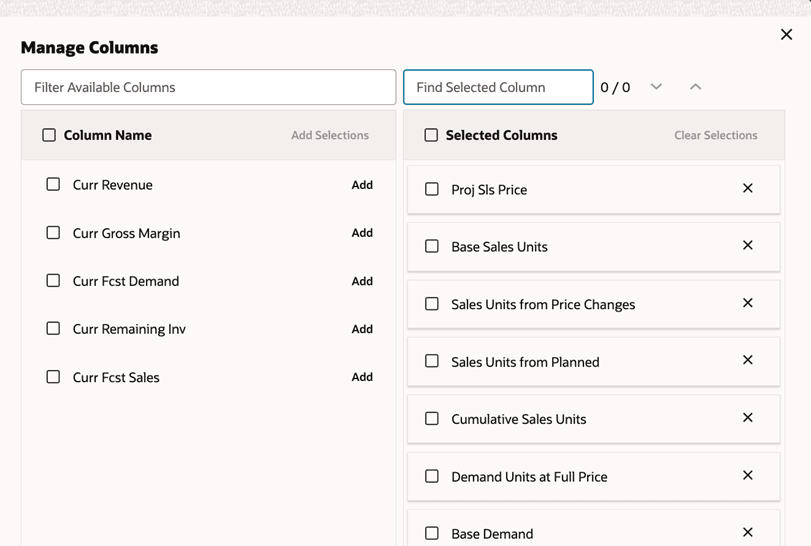1 Noteworthy Enhancements
Oracle Retail Analytics and Planning 25.2.401.0 is a Critical Update.
This guide outlines the information you need to know about new or improved functionality in the Oracle Retail Analytics and Planning applications update and describes any tasks you might need to perform for the update. Each section includes a brief description of the feature, the steps you need to take to enable or begin using the feature, any tips or considerations that you should keep in mind, and the resources available to help you.
Column Definitions
-
Feature: Provides a description of the feature being delivered.
-
Module Impacted: Identifies the module impacted associated with the feature, if any.
-
Scale: Identifies the size of the feature. Options are:
-
Small: These UI or process-based features are typically comprised of minor field, validation, or program changes. Therefore, the potential impact to users is minimal.
-
Medium: These UI or process-based features are typically comprised of field, validation, or program changes. Therefore the potential impact on users is moderate
-
Large: These UI or process-based features have more complex designs. Therefore, the potential impact to users is higher.
-
-
Delivered: Is the new feature available for use immediately after upgrade or must the feature be enabled or configured? If no, the feature is non-disruptive to end users and action is required (detailed steps below) to make the feature ready to use.
-
Customer Action Required: You must take action before these features can be used. These features are delivered disabled and you choose if and when to enable them.
Feature Module Impacted Scale Delivered Customer Action Required? Analytics and Planning (RAP) Analytics and Planning Batches
Medium
Yes
No
AI Foundation Advanced Clustering
Small
Yes
No
AIF Applications
Medium
Yes
No
SPO screens
Medium
Yes
No
Advanced Clustering
Small
Yes
No
AIF Applications
Medium
Yes
No
Credential Store Screen
Small
Yes
No
Batch
Small
Yes
No
UEX
Small
Yes
No
Rules Management: Handling Inactive or Reclassified Product Node Rule
Rules Management
Medium
Yes
No
Inventory Planning Optimization (IPO) Cloud Service Inventory Planning
Large
Yes
No
Inventory Planning
Medium
Yes
No
Inventory Planning
Medium
Yes
No
Inventory Planning
Medium
Yes
No
Inventory Planning
Large
Yes
No
Inventory Planning Business Rules & Strategies
Medium
Yes
No
Lifecycle Pricing Optimization (LPO) Cloud Service Enhancements Manage LPO Recommendations: Markdown Budget Update with Date Override
Manage LPO Recommendations
Medium
Yes
No
Manage LPO Recommendations
Medium
Yes
No
Manage LPO Recommendations: Custom Budget Checkbox Default Preferences
Manage LPO Recommendations
Medium
Yes
No
Manage LPO Recommendations: Accurate Result for Any Action Using Selected Option
Manage LPO Recommendations
Medium
Yes
No
Manage LPO Recommendations
Large
Yes
No
Manage LPO Recommendations: Rules for Promotion Markdown – Contextual Panel
Manage LPO Recommendations
Medium
Yes
No
Manage LPO Recommendations: Enhanced Price Path Contextual Panel with Detailed Correlated Charts
Manage LPO Recommendations, and LPO What-if Results
Large
Yes
No
Manage LPO Recommendations
Medium
Yes
No
Manage LPO Recommendations, LPO Run Overview, and LPO What-if Results
Small
Yes
No
Manage LPO Recommendations, LPO Run Overview, and LPO What-if Results
Small
Yes
No
Review Forecast
Small
Yes
No
Retail Insights Cloud Service Enhancements Reporting
Small
No
Yes – enable new batch jobs to integrate this data
Reporting
Small
Yes
No
Reporting
Small
Yes
No
Retail Predictive Application Server Cloud Edition Server Enhancement RPAS
Small
Yes
No
Retail Predictive Application Server Cloud Edition Client Enhancements RPAS
Small
Yes
No
RPAS
Small
Yes
No
RPAS
Small
Yes
No
Analytics and Planning Enhancements
Integration and Interface Updates
This release of Retail Analytics and Planning (RAP) applications includes the following updates to data integrations and commonly used batch programs in the AIF DATA batch schedule:
-
Numerous RDE extract programs were updated to support data recovery batch (DRB) runs, in which the AIF DATA business date is 1 or more days behind the MFCS business date and the batch needs to detect and extract data for the next date in sequence instead of the current MFCS date. More details can be found in the RAP Implementation Guide chapter on integration with Merchandising. This behavior will occur automatically based on the current business dates in AIF and MFCS at the time the batch runs. MFCS must be on version 25.1.301.0 or later for this functionality to be enabled.
-
New RDE job
RDE_BUSINESS_DATE_VAL_JOBhas been added and enabled by default for customers using RDE based integrations. This job compares the VDATE inRA_SRC_CURR_PARAM_Gwith the VDATE in source table PERIOD. The job will fail if the dates do not align. This is a safety validation to detect cases where data replication is lagging and it is not safe to begin the AIF nightly batch yet. -
Changes have been made to existing job BATCH_RUN_NIGHTLY_JOB to fail in POM if it detects a batch has already been run for the current business date. It is not supported to run the nightly batch more than once for the same business date, but there was no explicit validation or failure condition to prevent that scenario prior to this update.
-
New nightly batch job
TRUNCATE_ORG_PROD_RECLASS_TMP_JOBadded for cleaning up reclassification records after successful completion of the reclass, which prevents data issues in the scenario where a batch is restarted mid-run after a reclass was performed as part of that run. -
New nightly batch and standalone jobs are added in support of integrations for Transfer and Purchase Order CFAS attributes data. These jobs are disabled by default and do not need to be enabled unless you are intending to use these features.
-
New nightly batch and standalone jobs are added for custom hierarchy definitions, with all jobs starting with
W_RTL_CUSTOM_HIER*. These jobs are disabled by default and do not need to be enabled unless you are intending to use these features. -
New standalone process
RESET_BUSINESS_DATE_ADHOChas been added to simplify changing the current business date in the data warehouse (W_RTL_CURR_MCAL_G table). It contains a single job that performs all needed steps, including cleanup ofC_LOAD_DATESand setting the new date based on the POM parameter inputs. The old processLOAD_CURRENT_BUSINESS_DATE_ADHOCis still available but may be removed in a future release. -
New standalone process
RDE_BUSINESS_DATE_UPD_ADHOChas been added to simplify changing the MFCS business date used for RDE-based integrations (RA_SRC_CURR_PARAM_G table). It contains a single job that accepts a date as a parameter and updates the needed values in the configuration table. With the addition of this process, it is no longer required to make manual edits to theRA_SRC_CURR_PARAM_Gtable to align business dates. -
Certain database partitioning jobs and processes have been removed from the AIF DATA schedule as they are no longer required.
RUN_PARTITION_PRELOAD_VALIDATOR_PROCESS, RA_PARTITION_COLLECTION_JOB,andCREATE_PARTITION_EXECUTION_JOBhave been removed from most processes, allowing the automatic table partitioning programs to handle these functions going forward.
AI Foundation Cloud Service
Advanced Clustering – Exclude Closed Stores from Analysis
Advanced Clustering (AC) is used for store grouping in future planning, so any stores with closing dates should be excluded. Users will no longer buy products or allocate new stock to these stores, and therefore, cluster results should not include them.
Currently, when users create new cluster criteria, they must select a location hierarchy. However, after execution, closed stores are included in the analysis.
To address this issue an additional condition was added to an existing location check, whether it is to be excluded or not.
UI Update
For this release, we upgraded our UI framework, and as a result, there is a change to how the launch page will look on first startup. Previously, the AIF Launch Page showed the AIF Apps Task items directly. Starting with this version, on initial startup, the screen will display the Menu items, and you will need to select Tasks to get the AIF Apps Task items list.
Size Profile Optimization Screens Standardization
The Size Profile Optimization screens were updated to align the overall look and feel with the other AIF applications. The Dashboards that used to be displayed at the top have been removed as part of this standardization.
Advanced Clustering – Scenario Name Reset Issue
In Advanced Clustering, users access the Cluster Results screen of an executed cluster/scenario, then select the attributes they want to analyze. After selecting the attributes they want to analyze in the Cluster Hierarchy tab, changing the Scenario Name causes the system to default back to the initial Clusters tab. As a result, users must redo their attribute selections.
To address this issue, the UI was modified to preserve the list of attributes currently selected by the user when changing the Cluster Scenario. The attribute list will only be reset to default values if the current tab is refreshed, closed, or a new Cluster is viewed.
Tech Stack Updates
This release includes quarterly critical patch updates for underlying technology, uptake of Oracle Platform components and the DataStudio Quarterly Upgrade.
Credential Store Screen on Jet UI
In this release, the Credential Store screen has been re-platformed and moved from ADF to Jet UI.
Promotions Defined at Price Zone Level
The source of promotions and offers is typically Pricing Cloud Service. One of the features that needs to be specified is the location level, which can be location/store or price zone. This enhancement allows promotions/offers defined at price zone levels in Pricing Cloud Service to be processed in AI Foundation (AIF).
Oracle Digital Assistant
The Oracle Digital Assistant has been enabled for some screens in AIF Forecasting. Specifically, for Preprocessing and Estimation results. The user can query with respect to lost sales, promotion impact on demand, and seasonality pruning, among others.
Rules Management: Handling Inactive or Reclassified Product Node Rules
When rules are deactivated, either due to reclassification or because the associated product node is inactive, they remain visible in the Rules Management UI. Users can filter to view all inactive rules (where the Merchandise Active Flag is indicated as No in the Rules Management table), and then use the Update & Copy function to reassign these rules to an active product node.

Inventory Planning Optimization (IPO) Cloud Service Enhancements
Allocation Workflow
A user-driven workflow is being introduced for allocating PO inventory and inventory in the DC. The locations, policies, and constraints are used to calculate an optimized allocation recommendation. The recommendation can be edited, recalculated, or exported to Merchandising Foundation Cloud Service for execution.
Assortment Plan Demand
The Assortment Planning Cloud Service receipt plan and sales plan are now integrated for use in calculating allocation store need during the user-driven process.
Capacity Constraints
Capacities can be set at a store level or product/store level. The capacity is compared to projected inventory levels and tolerances to alert the inventory planner when orders violate capacity. When auto-approval is enabled, orders that would exceed capacity tolerances are not automatically approved.
Holdback Stock
Holdback stock allows an inventory planner to withhold stock in a warehouse for any reason. The stock can be held for a finite period or indefinitely until modified. The held stock shows ‘on-hand’ but is deducted from the warehouse net inventory so that it is unavailable to meet demand. This can be used when the user wishes to hold back inventory in the DC to be used to replenish the stores or can drive additional replenishment quantity when planned in advance.
Lifecycle Pricing Optimization (LPO) Cloud Service Enhancements
Manage LPO Recommendations: Markdown Budget Update with Date Override
The “Markdown Budget Used” (“Mkdn Bdgt Used”) metric in Manage LPO Recommendations has been enhanced to automatically recalculate when a markdown is shifted to a different week using the Date Override feature. Once the recalculation is complete and the screen refreshes, users will see the updated markdown budget, which reflects projected sales from the current date to the newly selected effective date. This behavior can be controlled using the configuration parameter PRO_DATE_OVERRIDE_RECALCULATE, where Y enables adjustment and N (the default) leaves the value unchanged.
Manage LPO Recommendations: Ability to Add Computed Columns
Creating custom computed columns is now supported directly within the Manage LPO Recommendations table. Users can define custom calculations, such as “Rec GM % = Proj Margin/ProjSales,” using available data fields and have these metrics displayed in their workspace for actionable insights. To add a custom calculated metric, select Computed Columns from the View Menu in the Manage Recommendations table and create a new column with your chosen expression. This enhancement enables users to quickly set up and utilize personalized metrics in their workspace.
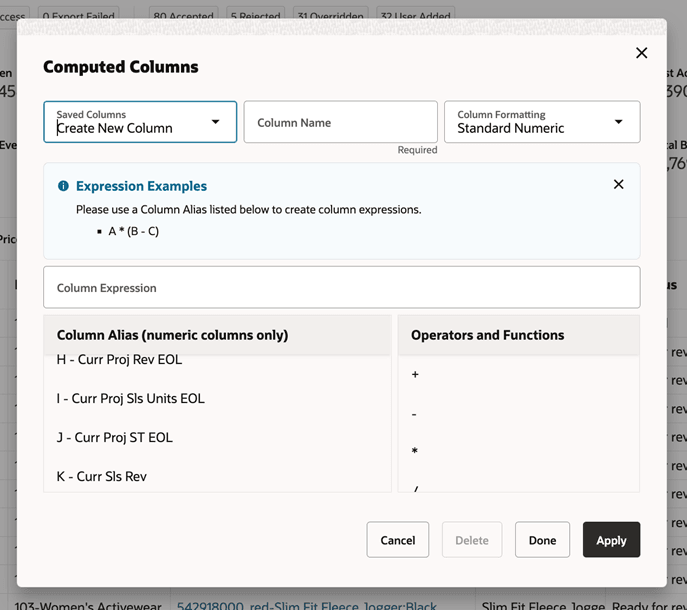
Manage LPO Recommendations: Custom Budget Checkbox Default Preferences
Default selections for checkboxes, including Retain Overridden Promotions, Retain Overridden Markdowns,
Include Planned Promotions, Retain Approved, Retain Reviewed, Retain Submitted, and Separate Budgets, can now be saved across the user sessions. Depending on the user’s selections, the preferences are automatically preserved and applied each time the Custom Budget window is accessed, including after performing actions like Revert or Optimize.
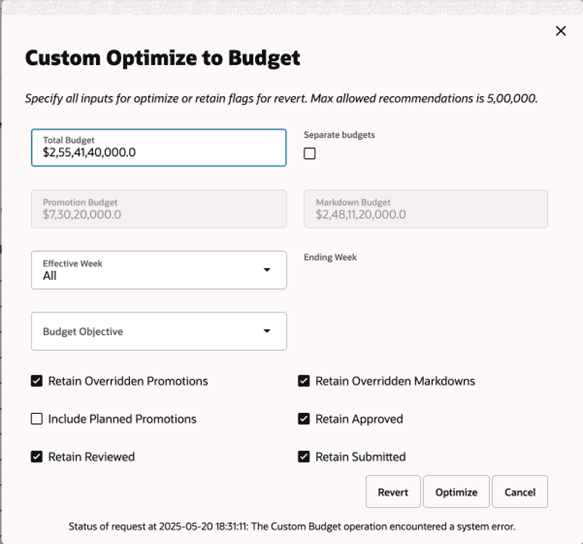
Manage LPO Recommendations: Accurate Result for Any Action Using Selected Option
When a user performs any bulk action using the Selected option, the system now ensures that the outcome of that action, such as Review, Undo Review, Approve, Undo Approve, Submit, or Undo Submit (available under the Finish button), is accurately captured from the database and immediately reflected in the Manage LPO Recommendations view.
Manage LPO Recommendations: Pivot Table
Pivot table functionality has been implemented as an early release in the Manage Recommendations table, enabling users to quickly summarize, analyze, and visualize recommendation data from multiple perspectives. Users can easily configure rows, columns, and values such as price zones, recommendation status, class, and key metrics (for example, Recommended Price, Current Price, Total Inventory) using a flexible drag-and-drop interface. The Pivot Table can be accessed by selecting the Pivot option from the Actions menu in the Manage LPO Recommendations table.
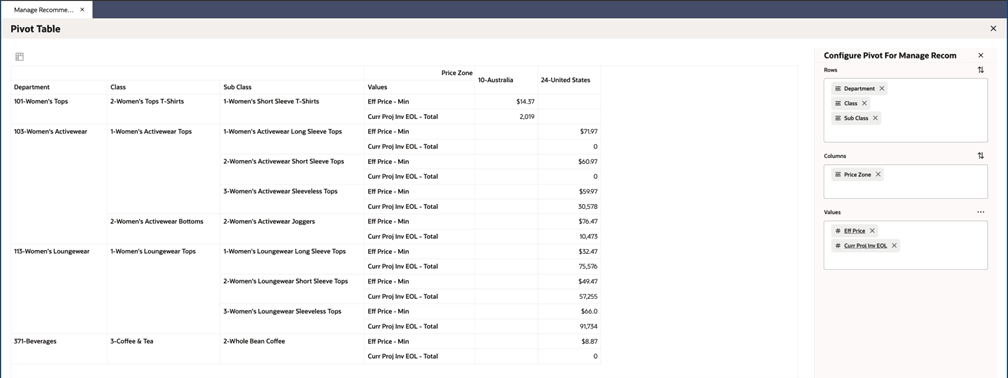
Users can specify which columns are available for pivoting and
select aggregation options through the metadata table RSE_PIVOT_CONFIG_COLUMN_MD. These settings are managed through Manage System Configurations.
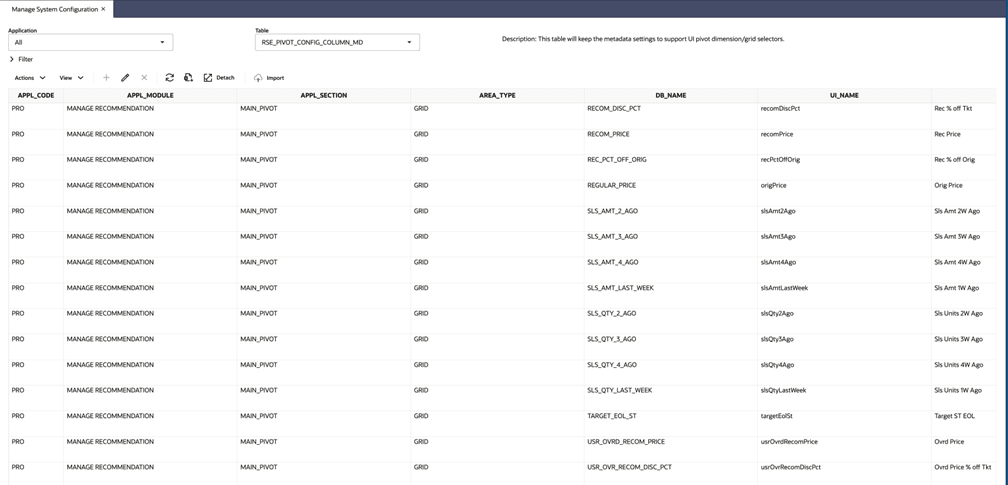
Manage LPO Recommendations: Rules for Promotion Markdown – Contextual Panel
The Contextual Rules panel has now been extended to include Promotion and Markdown items in the Manage LPO Recommendations and What-If Run Results screens. When an item is selected, all relevant promotion and markdown rules applied to the item are displayed directly within the right-hand Rules panel for easy review.

Manage LPO Recommendations: Enhanced Price Path Contextual Panel with Detailed Correlated Charts
The Price Path contextual panel in the Manage LPO Recommendations screen has been upgraded to provide a clearer and more comprehensive visualization of item performance over time compared to the status quo. Previously, projected Sales Path and Inventory Path were displayed together in a single chart. Now, these have been separated into distinct, correlated charts Price Path, Sales Path, and Inventory Path for better visibility and analysis. Additionally, a new Gross Margin Path chart has been introduced, featuring key profitability metrics such as Gross Margin and Current Margin. This enhancement provides users with a more detailed, transparent view of pricing, sales, inventory, and gross margin trends.

Manage LPO Recommendations: GenAI Performance Improvement
The performance of GenAI within the Manage Recommendations screen has been enhanced to deliver faster response times and a smoother user experience. Interactions with GenAI, including generating recommendations and insights, are now processed more quickly, enabling users to work more efficiently and with reduced wait times.
Advanced Filtering with “Not Contains” in Query Builder
Expanded filtering capabilities have been added to the Query Builder throughout the LPO Manage Recommendations, LPO Run Overview, and LPO What-if Results screens.
A new “not contains” operator now allows explicit exclusion of patterns or values when filters are built. Parentheses can be used to group conditions and enhance AND/OR logic.
For example, a query can now be constructed as follows:
Price Zone Not Contains 'CO' AND (Ticket Price ends with .97 OR Ticket Price ends with .93 OR Ticket Price ends with .87 OR Ticket Price ends with .84)
All records will then be returned that exclude price zones beginning with CO, with ticket prices ending in .97, .93, .87, or .84.
To perform this action, first select the columns, choose the applicable operator (such as =, !=, contains, not contains, or in), enter the desired values, and set And/Or conditions. Nested groups can be created by clicking the three dots beside a column and selecting columns to group within the query.
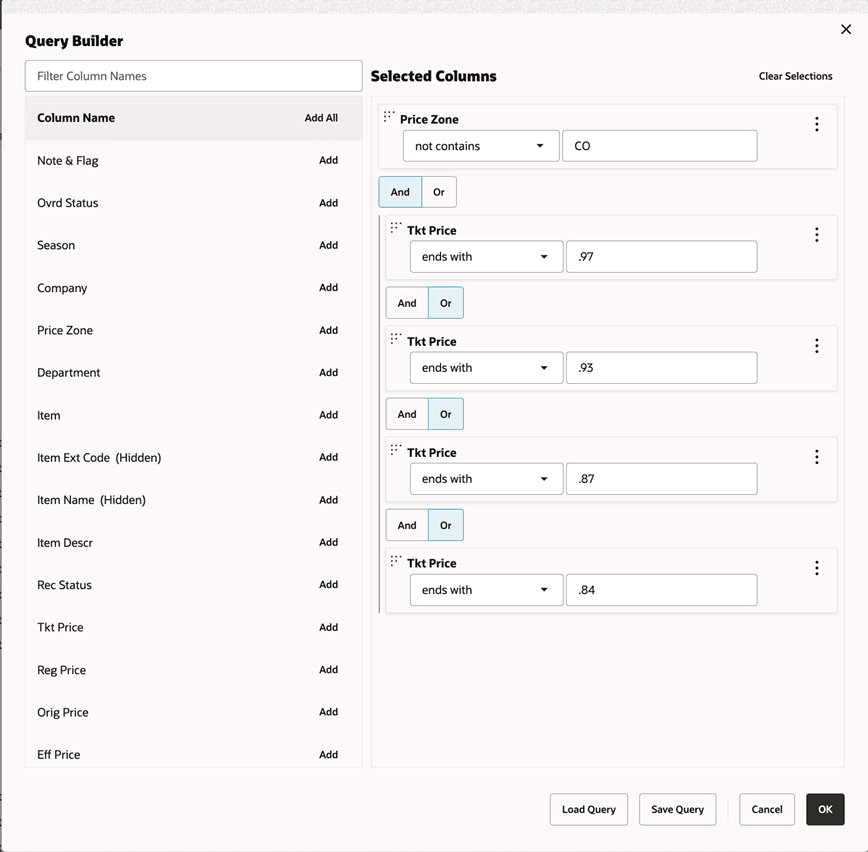
Ability to Save Multiple Column Configurations
The Manage Columns in the View menu of LPO Manage Recommendations, LPO Run Overview, and LPO What-if Results screens now supports saving, naming, and managing multiple custom column configurations (views). This allows users to easily switch between various column setups for exporting, reporting, or analysis, without needing to reselect columns each time.
To create a new column set, open the Manage Columns option from the View Menu in the Manage Recommendations table, choose or remove the desired columns, and then select Save Column Set to store your configuration.

To access a saved column set, click Load Column Set and select the preferred column set name from the list.

Retail Insights Cloud Service Enhancements
Custom Flex Attribute (CFAS) Integrations
New interfaces have been established to load Custom Flex Attributes for Purchase Orders (both header and detail) and Transfers (header only). These datasets may be loaded directly from Merchandising or by using flat-file interfaces. New database tables are available in the data warehouse for this data and they have been exposed to Retail Insights (RI) reporting in this release. All new jobs are disabled by default and must be manually enabled in the AIF DATA batch schedule if you wish to use these interfaces.
New tables are listed below, and the jobs in POM will use a similar naming scheme based on the table name:
-
Purchase Order –
W_RTL_PO_DETAILS_DS_CFA, W_RTL_PO_DETAILS_D_CFA -
Purchase Order Item/Location –
W_RTL_PO_DETAILS_IT_LC_DS_CFA, W_RTL_PO_DETAILS_IT_LC_D_CFA -
Transfers –
W_RTL_TSF_DETAILS_DS_CFA, W_RTL_TSF_DETAILS_D_CFA
New Reporting Metrics
Retail Insights will include the following new metrics and attribute for reporting purposes in this release.
| Functional Area | Change Summary |
|---|---|
|
Customer Order |
New attributes added for flex fields on the customer order line dimension (W_RTL_CO_LINE_D). |
|
Item |
New attributes for Color Industry Code and Color Industry Subgroup have been exposed from existing database columns in the W_RTL_ITEM_GRP1_D table. |
|
Pricing |
New metrics have been added to expose existing columns on the Pricing tables such as the Last Markdown Price, Last Promo Price, Last Regular Price, and other calculated measures. |
|
Purchase Order Attributes |
New attributes added for custom flex attribute data in the W_RTL_PO_DETAILS_D_CFA and W_RTL_PO_DETAILS_IT_LC_D_CFA tables. |
|
Transfer Status Attributes |
New attributes added for custom flex attribute data in the W_RTL_TSF_DETAILS_D_CFA table. |
Customize Folder Visibility
Retail Insights now supports the ability to hide folders from the
as-is and as-was subject areas as a configuration option. Folder visibility
is controlled using the existing metric visibility configuration table C_RPD_METRIC_VISIBILITY. Folder names will be listed as
new records in this table having a METRIC_NAME value
of ALL. Changing the ACTIVE_FLG value on these rows to N will cause
the entire folder to be hidden from view in the user interface. The
visibility changes do not take effect immediately; you are required
to raise a Service Request to have the changes applied to your environment
after updating the configuration table.
Retail Predictive Application Server Client Enhancements
Improved Export to Excel
Export to Excel functionality has been enhanced to allow users to export images while exporting planning data, not merely image URLs. This allows user to view the image of the product and review the metrics or save the planned data along with product images for any future reference.
Note:
This functionality requires a specific version of Microsoft Excel and a content manager server that has https with valid SSL certificates.